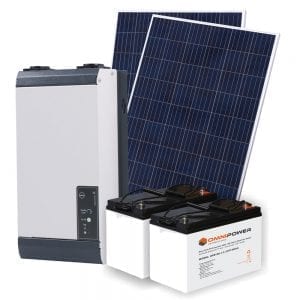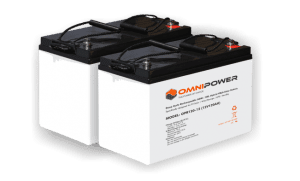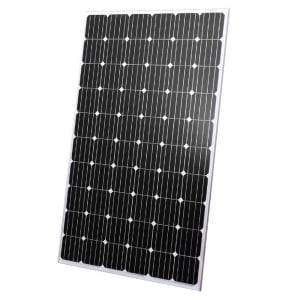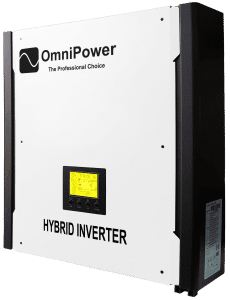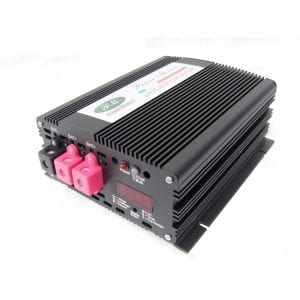Voltage: This is what pushes electricity through a circuit – the “driving force”. Units = Volts
Current: This is what is pushed through by the voltage – the “flow”. Units = Amperes (Amps)
Electrical Power: When voltage and current work together to do something useful – such as turn a motor or light a lamp. Units = Watts
Watts and kW are a measure of power. 1000 Watts = 1kW
1 horsepower (HP) = 746 Watts
Load: Your load is the combined power rating (in Watts or kW) of all the devices you want to power via your system.
Calculating Power Ratings
Most devices and appliances will clearly display their power rating (in W or kW) in their user manual, or on a sticker at the rear or bottom. If you cannot find this information anywhere, and instead find ratings in V and A, you can perform the following calculations:
To get VA = Volts x Amps
To get Watts = Volts x Amps x Power Factor
VA will always be equal to or higher than your Watts rating.
What is a Power Factor?
Power factor (PF) indicates how well the current and voltage are working together. Some examples of the power factor of appliances include:
- Incandescent Lamps operate at 100% efficiency
- Large Motors operate at 80-90% efficiency
- Small Motors operate at 60-75% efficiency
What’s the difference between kW and kVA? And how do you convert between the two?
kVA: apparent power
VA and kVA is a measure of apparent power: it tells you the total amount of power in use in a system. In a 100% efficient system kW = kVA. However electrical systems are never 100% efficient and therefore not all of the systems apparent power is being used for useful work output.
kW: actual power
W and kW is the amount of power that is converted into a useful output. kW is therefore known as actual power or working power.
When you want to know how much electricity is costing you, you use watts. When you are specifying equipment loads, fuses, and wiring sizes you use the VA, or the rms voltage and rms amperage. This is because VA considers the peak of both current and voltage, without taking into account if they happen at the same time or not.
You can convert between kVA and kW if you know the efficiency of the electrical system (ie your inverter or UPS). Electrical efficiency is expressed as a power factor between 0 and 1: the closer the power factor is to 1, the more efficiently the kVA is being converted into useful kW. Generators have a power factor of 0.8.
The formula for converting kVA into kW is:
Apparent power (kVA) x power factor (pf) = actual power (kW)
e.g. 100 kVA x 0.8 = 80 kW
The formula for converting kW into kVA is:
Actual power (kW) / power factor (pf) = apparent power (kVA)
e.g. 100 kW / 0.8 = 125 kVA
What’s the difference between kW and kWh?
A kilowatt (kW) is a measure of power. For example, a 1000 Watt drill could also be called a 1kW drill.
A kilowatt hour (kWh) is a measure of energy. So a 1000 Watt drill needs 1000 Watts (1 kW) of power to make it work, and uses 1 kWh of energy in an hour.
A kWh is a unit of measurement that equals the amount of energy you would use if you kept a 1000 Watt appliance running for an hour:
- If you switched on a 100 W light bulb, it would take 10 hours to rack up 1kWh of energy.
- A 2 000W appliance would use 1kWh in just half an hour.
- A 50W item could stay on for 20 hours before it used 1kWh.
It’s hard to be precise, because similar appliances can have very different power ratings wattages, but here are some rough examples of 1 kWh:
- Using a 10 000W (10kW) electric shower for six minutes
- Keeping an immersion heater (3000W) on for 20 minutes
- Cooking in a 2000W oven for half an hour
- An hour’s ironing with a 1000W iron or 45 minutes with a 1500W iron
- Less than an hour using a dishwasher (1,000 – 1,500 watts)
- Around three hours watching a plasma TV (280W – 450W)
- Keeping a fridge-freezer (200W – 400W) on for about three hours
- Keeping an electric blanket (130W – 200W) on all night
- Using a laptop (+-50W) all day
- Keeping a broadband router (10W) on for five days
What is an Amp Hour (AH)?
An Amp Hour (Ah) rating on a battery is the amount of current that battery can supply for a certain period of time.
The Amp Hour rating is a 20 Hour rating.
A 12V battery rated for 100 amp hours will provide 5 amps for 20 hours.
How do I convert Ah to kWh?
If we have a 12 volt battery, we multiply Ah (100Ah) by nominal voltage (12V) and determine that the battery will provide 1200 watt hours.
To apply the metric ‘kilo’ prefix, we divide the result by 1000 and we determine that the battery can supply 1.2kWh.
It is important at this point to keep in mind that the Ah rating is a 20 Hour rating, therefore it is necessary to treat any kilowatt conversion you make as a 20 hour rating as well.
In the case of our 1.2kWh conversion, we need to understand that what is really being said is that the battery will provide 60 Watt Hours for 20 Hours.
Batteries connected in Parallel vs Series
Parallel Connections: You up the current or amps, voltage remains the same (ie 2 x 12V 100Ah batteries connected in parallel = 12V 200Ah)
Series Connections: You up the voltage, current or amps remains the same (ie 2 x 12V 100Ah batteries connected in series = 24V 100Ah)
While amp hours remain the same in batteries connected in series, voltage does not. That means the power capacity has increased. The Watt Hours have increased to 2400 watts.
This particular characteristic can be a contributor to choosing 24 Volt Systems.
Wire size selection is largely based on the current that the wire must carry. The more current, the larger the wire. The larger the wire, the more expensive it is. Systems based on 24 volts can carry the same amount of power on smaller wire.

